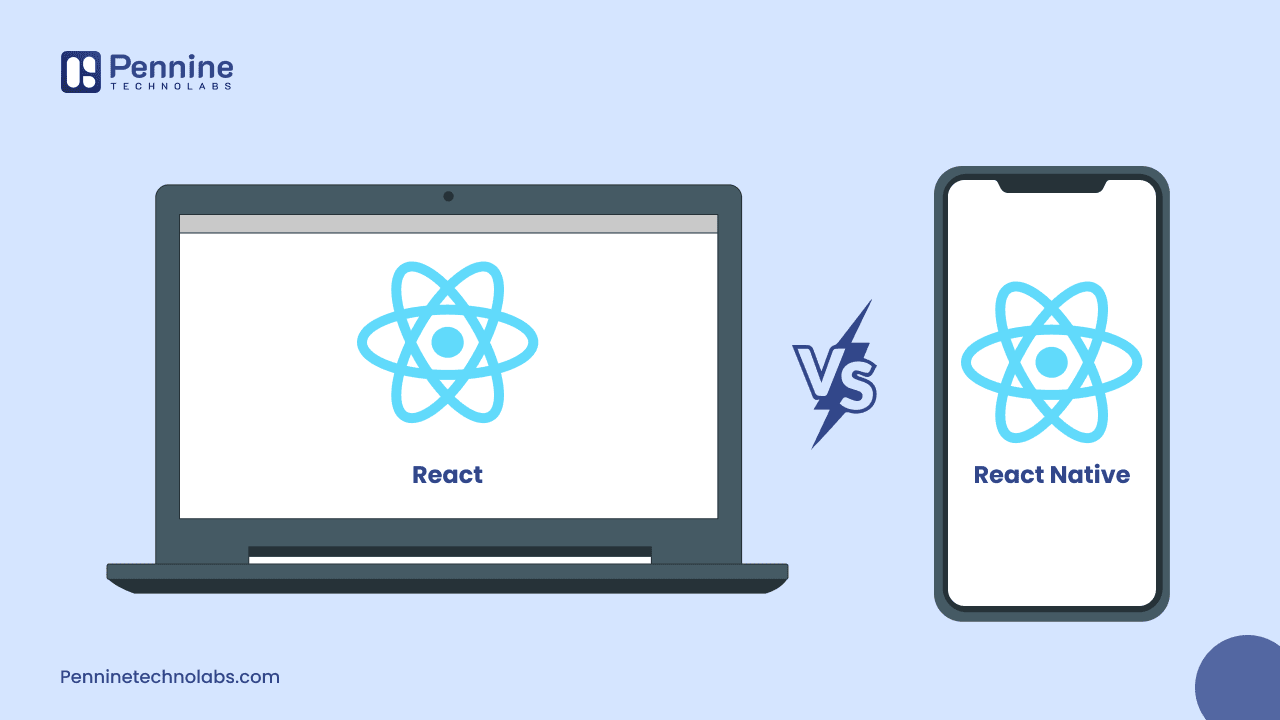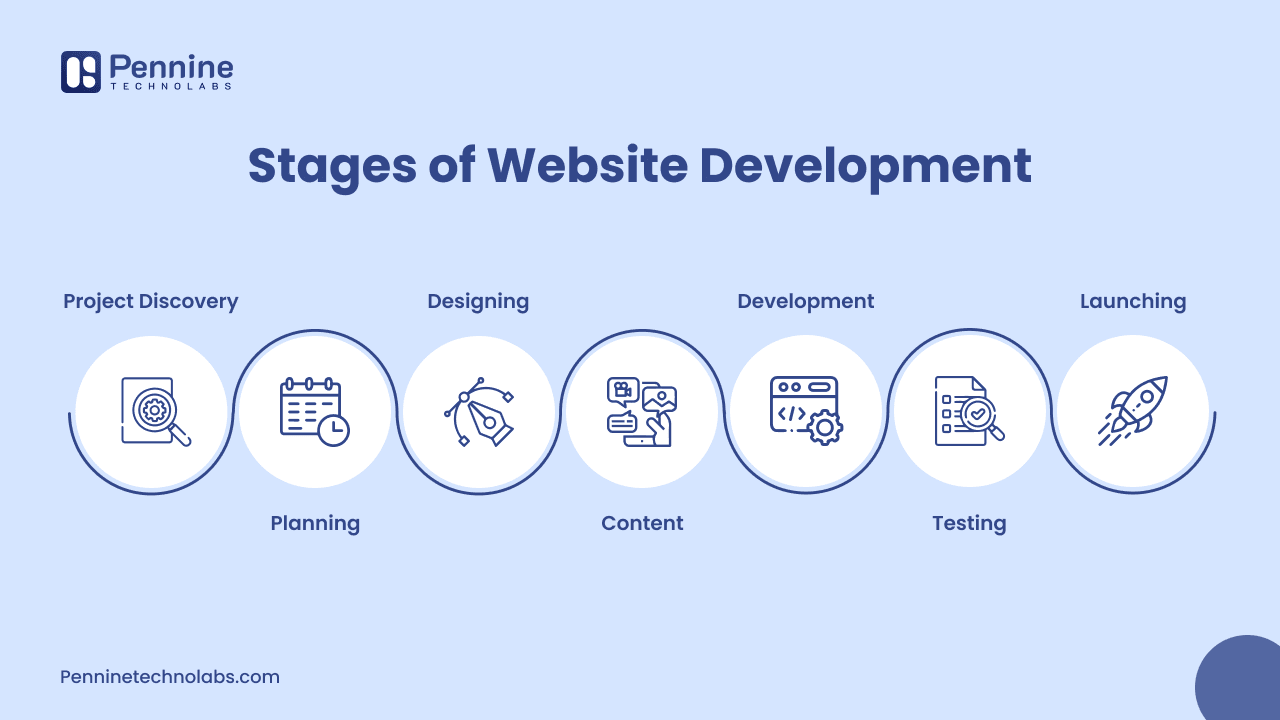Quick Summary: React and React Native are two of the most common platforms for making modern web apps, although they do differ from one another. React is for making web interfaces that change and interact with users, whereas React Native is for making mobile apps that use the same JavaScript code as React. This blog talks about the differences, pros, and cons of each one to help you pick the best one for your project. Find out how each technology can affect the next digital product you make.
Introduction
Have you ever experienced some websites and apps looking the same on a browser and a smartphone?
Behind that smooth experience, there are two powerful technologies – React and React Native. Both were created by Meta and share the same basic philosophy, but serve completely different purposes. ReactJS powers dynamic and responsive web applications, while React Native brings those same concepts to life on mobile devices.
Choosing between React and React Native has become an important decision for developers and global businesses. React dominates web development with over 11 million websites globally, while React Native is the leader in cross-platform mobile development with 42% market share in the mobile app development sector.
What is React.js?
React.js Web Development, often referred to as React, is a part of the JavaScript library used to create interactive user interfaces, especially for single-page web applications. The library allows web developers to create reusable UI components that efficiently update and present data without refreshing the page. Its declarative structure makes code predictable and easier to debug.
React.JS Purpose
The main purpose of React.js is to simplify frontend development along with the process of building scalable, high-performance web applications. It efficiently manages the view layer of a web application, ensuring a smooth and responsive user experience.
React.JS Output
React web applications are compiled to standard web technologies – HTML, CSS, and JavaScript that run in web browsers. The library renders components of the Document Object Model (DOM), creating dynamic web pages that can respond to user interactions and data changes in real time. React’s virtual DOM implementation results in faster updates and improved application speed.
React.JS Components
React is completely component-driven. Each component encapsulates its own logic, design, and state, making it easy to reuse and maintain. This modular architecture supports cleaner code organization and increases collaboration across teams.
React.JS Platform
React.js is completely web-focused. It is ideal for developing applications that run in the browser, such as dashboards, social platforms, or ecommerce interfaces. With the Next.js framework, this can also be extended to server-side rendering and static site generation.
What is React Native?
React Native is a framework that allows developers to create mobile applications using JavaScript and React’s component-based architecture. Instead of rendering web components, it translates them into native UI elements, providing the same performance and experience as traditional native apps built in Swift, Java or Kotlin.
React Native Purpose
React Native aims to bridge the gap between web and mobile development by allowing code reusability across all platforms. This enables developers to use one codebase for both iOS and Android, significantly reducing development time and effort.
React Native Output
The framework compiles native code, creating true mobile applications rather than web views. This ensures smooth animations, faster load times, and a consistent user experience across all devices.
React Native Component
React Native uses native components instead of HTML elements. Elements like <View>, <Text>, and <Image> replace traditional web tags, interacting directly with the native API. This approach gives developers full access to device features like cameras, sensors, and GPS.
React Native Platform
React Native targets mobile platforms, specifically iOS and Android. However, through extensions like React Native for Windows and macOS, developers can also expand to desktop environments.
Difference between React Native and React.JS
| Aspect | React.js | React Native |
|---|---|---|
| Target Platform | Web browsers (desktop & mobile web) | Native mobile apps (iOS & Android) |
| Rendering | Renders to DOM | Renders to native components |
| Styling | CSS, CSS-in-JS, styled-components | StyleSheet API (CSS-like syntax) |
| Navigation | React Router, browser-based routing | React Navigation, native navigation |
| Development Tools | Browser DevTools, React DevTools | Metro bundler, native debugging tools |
| Deployment | Web servers, CDNs | App stores (Apple App Store, Google Play) |
| Performance | Optimized for web browsers | Near-native mobile performance |
| Code Reusability | Web-specific components | Cross-platform mobile components |
| Learning Curve | Web development knowledge required | Mobile development concepts needed |
React vs React Native: Advantages
React.js Advantages
Mature Ecosystem: React boasts an extensive ecosystem with over 2.1 million NPM packages, providing solutions to any web development challenge. Popular libraries include Material-UI, Redux, React Router, and countless others.
SEO-friendly: React applications can be optimized for search engines through server-side rendering (SSR) technologies, with SSR implementations showing up to 20% better search engine rankings.
Big Developer community: With over 207,000 GitHub stars and 22 million weekly NPM downloads, React has one of the largest and most active developer communities, ensuring comprehensive support and resources.
Performance Optimization: React’s virtual DOM and efficient algorithms result in 15-20% faster rendering than other JavaScript libraries.
Flexibility: React is a library, not a framework, which gives developers the freedom to choose their preferred tools for state management, routing, and other functionalities.
React Native Advantages
Cross-platform development: React Native enables 60-80% code sharing between iOS and Android platforms, significantly reducing development time and cost.
Native performance: Unlike hybrid solutions, React Native renders native components, providing performance close to fully native applications.
Reloading: Fast refresh in React Native allows developers to see changes immediately, improving development efficiency.
Access to Native APIs: React Native provides access to device-specific features like cameras, GPS, push notifications, and sensors through native modules.
Cost-effective: Companies can save up to 40% in development costs compared to building separate native applications.
Cons of React JS vs React Native
React.js Disadvantages
Steep learning curve: React includes complex concepts like JSX, component lifecycle, and advanced state management, making it challenging for beginners.
Rapid Evolution: React’s fast-paced updates can create challenges for developers trying to keep up with new features and best practices.
SEO Complexity: While SEO is possible, it requires additional configuration for server-side rendering or static site building.
Ecosystem fragmentation: The sheer number of third-party libraries can lead to decision paralysis and potential compatibility problems.
Not a full framework: React focuses only on the view layer, which requires additional tools for routing, state management, and API handling.
React Native Disadvantages
Performance limitations: While good for most applications, React Native doesn’t match the performance of fully native solutions for computationally intensive tasks.
JavaScript bridge overhead: The communication between JavaScript and native code can create performance bottlenecks.
Limited Native API Access: Some platform-specific features require custom native modules, demanding knowledge of Swift, Kotlin, or Objective-C.
Debugging complexity: Debugging a React Native application can be challenging due to the multi-layer architecture involving JavaScript, native code, and the Bridge.
Third-party library dependencies: Heavy reliance on community-maintained packages can lead to compatibility issues and missing libraries.
Platform-Specific UI Differences: Achieving pixel-perfect UI consistency across platforms can be challenging and may require platform-specific code.
Real-time Stats for React JS and React Native
React.js Statistics 2025
- Global Usage: React powers 11+ million websites worldwide, representing 5.8% of all websites. Citrusbug+2
- Market Share: React has 40% of the web framework market share and 5.9% of the JavaScript library market. Netguru+1
- Developer Adoption: 41.6% of professional developers use ReactJS, making it the second most popular framework. Esparkinfo
- Performance: React sites render 15-20% faster than alternative JavaScript libraries. Esparkinfo
- Community Engagement: 207,000+ GitHub stars and 22 million weekly npm downloads Esparkinfo
- Geographic distribution: 2.97 million live websites in the US use React. Esparkinfo
React Native Statistics 2025
- Market Share: React Native holds 42% of the cross-platform mobile development market Metadesignsolutions+1
- Developer Usage: 9.14% of professional developers use React Native Nomtek
- Code Sharing: Projects typically achieve 70-85% code reuse across platforms Metadesignsolutions
- Job Market: 6,413 React Native job postings on LinkedIn US vs 1,068 Flutter jobs Dev
- Growing Adoption: React Native’s market share has grown from 4.73% in 2022 to 6.75% in 2024 Ripenapps
What should you choose: React.js vs React Native?
The choice between React and React Native will depend on the needs of your project and the platforms you aim to reach. React.js websites remain the most popular way to build websites because they have a mature framework, a large community of members who can help, and a proven track record of powering millions of websites around the world. It has a 40% market share among web frameworks and gets over 20 million downloads a week, which indicates it is still important and growing.
React Native has become the most popular cross-platform mobile solution, taking 42% of the mobile app development market and allowing developers to save a lot of money by reusing code. It is a good choice for organizations that want to reach mobile consumers since it can give performance that is almost as good as native apps while keeping development costs low.
React.js has the best flexibility, SEO features, and ecosystem maturity for web-first projects. React Native is the best option for mobile-first projects because it strikes the right balance between native functionality and development speed. Companies that need to be on both the web and mobile might choose to use a hybrid strategy that uses React’s component philosophy on both platforms but also recognizes the need for customization for each platform.
Conclusion
The future looks bright for both technologies, with React maintaining its web dominance and React Native continuing to grow with architectural improvements and advanced native integration capabilities.
At Pennine Technolabs, we specialize in building scalable web and mobile solutions using modern frameworks like React.js web development and React Native mobile app development. Our team combines technical expertise with creative problem-solving to deliver applications that perform flawlessly and engage users on every platform. Whether you’re starting a new project or optimizing an existing project, we can help you transform your vision into a powerful, high-performance digital experience.
FAQs on React.JS vs React Native
Can I use the same codebase for both React and React Native applications?
While both share similar JavaScript and React principles, the UI components and platform-specific APIs are different. You can share business logic, utilities, and state management, but UI components need to be platform-specific.
How much can I save by using React Native instead of native development?
Experts show that React Native can reduce development costs by 30-40% compared to building separate native applications, primarily due to code sharing and faster development cycles.
Is the performance of React Native really comparable to native apps?
For most applications, React Native provides near-native performance. However, for graphics-intensive applications, games, or apps requiring heavy computational work, fully native development may be more appropriate.
Can React developers easily learn React Native?
Yes. Since both use JavaScript and share component-based logic, React developers can transition to React Native with relative ease.
Can React.js be used for mobile applications?
Not directly. However, React.js skills can be transferred to React Native, which is designed for mobile platforms.
Which is better for startups: React or React Native?
For a web-based MVP, React.js is ideal. For mobile-first startups aiming for cross-platform reach, React Native offers better value.
Do React and React Native share the same libraries?
Some libraries overlap, but many are platform-specific. React Native includes libraries ready for mobile environments, such as camera access and gesture handling.



